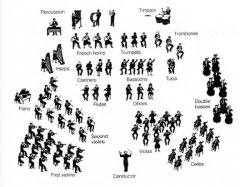![]()
![]()
![]()
Use LEFT and RIGHT arrow keys to navigate between flashcards;
Use UP and DOWN arrow keys to flip the card;
H to show hint;
A reads text to speech;
41 Cards in this Set
- Front
- Back
|
Musical Textures |
Monophonic, Homophonic, Polyphonic |
|
|
Monophonic Texture |
one melody only (can be many voices or instruments singing or playing in unison) |
|
|
Homophonic Texture |
one melody with accompaniment (most of the music we hear) |
|
|
Polyphonic Texture |
more than one melody at once (can be imitative or nonimitative (free) counterpoint) |
|
|
Scale |
an arrangment of pitches that ascends and descends in a fixed and unvarying pattern (musical ladder) |
|
|
Interval |
the distance between two notes (consonance and dissonance) |
|
|
Consonance and Dissonance |
tension/ relaxation or resolution (stable or unstable) |
|
|
Musical Phrase |
(row your boat) 1st phrase Row, row, row your boat gently down the stream (then the melody changes); Merrily, merrily, merrily, merrily, life is but a dream; a portion of a melody theme or tune |
|
|
Melodic Motion |
the spacing of notes in a melody |
|
|
Contour |
shape of the melody |
|
|
Sequence |
reuse of melodic material at different pitch levels |
|
|
Repetition |
reuse of melodic material at the same pitch level |
|
|
Harmony / Chord |
simultaneous sounding of 3 or more tones/ pitches |
|
|
Apreggio |
broken chord |
|
|
Key |
tonality (minor = sad; major = happy); tonic chords on the 1st step |
|
|
Modal Scales (Modes) |
scales that aren't in minor nor major (e.g. pentatonic scale, blues scale) |
|
|
Cadences |
stopping points in a piece |
|
|
Beat |
pulse |
|
|
Meter |
(triple, duple); an organized pulse (2/4, 3/4, etc.) |
|
|
Tempo |
the speed (largo, andante, allegro, vivace) |
|
|
Dynamics |
piano, pianissimo, mezzo piano, forte, fortissimo, mezzo forte, diminuendo |
|
|
Crescendo |
increase |
|
|
Decrescendo |
decrease |
|
|
Form |
two part, three part, reprise = return, ABA (Twinkle Little Star) |
|
|
Voice Types |
soprano, alto, tenor, baritone, bass (these are the human) |
|
|
Conducting Patterns |

|
|
|
Timbre |
tone color |
|
|
Techniques Used in Playing Instruments |
vibrato, trill, pizzicato, chords, different bow strokes, ricochet |
|
|
Orchestral Instruments |
be responsible for orchestra seating chart; who is in the string, woodwind, brass and percussion families;, concertmaster, conductor; |
|
|
Other Instruments |
harpsichord, harp, guitar, pitched and unpitched percussion, organ, synthesizer |
|
|
Seating Chart |

|
|
|
Rehearsals |
practicing individually or together (unifying tempo, expression, and interpretation) |
|
|
Emotion in Music |
all ideas expressed emotionally (i.e. major and minor) |
|
|
Performance Etiquette |
Symphony, Opera, Jazz |
|
|
Middle Ages |
400-1400 AD, Kyrie - Anonymous |
|
|
Renaissance |
1400-1600, Casulana - Madrigal |
|
|
Baroque |
1600-1750, Handel - Hallelujah Chorus |
|
|
Classical |
1750-1800, Mozart - Minuet |
|
|
Romantic |
1800-1900, Liszt - Trancendental Etude |
|
|
20th Century |
1900-2000, Charles Ives - Three Places in New England |
|
|
Jazz |
20th Century, Benny Harris - Crazeology |

